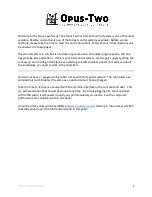
Page 13
@D2
Stop sending display data
Unit stops sending display data
@D3
Send last calculated reading
This value is changed as fast as the throughput of the ACT unlike the
@D0 command that gives the last displayed value which only changes up
to 2 times per second. In the Rate of Change (ROC) mode this command
will give the last RPM measured. To get the displayed ROC value, use the
@D0 or @D1 commands.
@MX
Send Maximum value
Unit sends Maximum value once
@MN
Send Minimum value
Unit sends Minimum value once
@RE 32
Reset Maximum value
Unit sends OK when done
@RE 64
Reset Minimum value
Unit sends OK when done
@RE 96
Reset Max and Min
Unit sends OK when done
6.2.2
Control Commands
NOTE:
Control
commands may affect the operation of the instrument so the user should proceed with caution
if the unit is in an operational environment.
CAUTION:
Relays may drop out or pull in during set up.
A COMMAND is an instruction to the unit to change one or more of its operating parameters. It consists of the @
symbol followed by the Command (,) a category (, or =) and an argument followed by a carriage return (Enter). If a
command is given without an argument, the unit will return the current setting. For example: @CH_1,TYPE=RPM will
change the mode to RPM and @CH_1,TYPE will return the answer RPM. In some cases the argument is followed by a
numerical value. For example: @CH_1,TYPE,SCALE=60.0 will change the scale factor to 60.0. (
NOTE: The unit
must be set to the Scale Mode first for the Scale factor to be recognized.
) Incomplete commands will be ignored.
The following are valid
Control
Commands:
Command,Category (eg. @CH_1,TYPE will return the current Type setting for Channel 1)
Command,Category = Argument (eg. @CH_1,TYPE=ROC sets the Channel 1 Type to Rate of Change)
Command,Category,Argument = Value (eg. @CH_1,TYPE,SCALE=60.0 sets the Scale Mode Scale factor to 60.0)
Command = Argument (eg. @DECPT=NONE sets the Decimal Point to none)
Command
Category
Argument
Action
@CH_1
(Channel 1)
TYPE
RPM
Sets scale to 60 so displays in RPM.
FREQ
Sets scale to 1 so displays in hertz.
SCALE
Scale mode. Enter Scale factor.
SECAP
Single Event Capture. Enter Scale factor.
ROC
Rate of Change. Enter Scale factor.
TOTAL
Totalizer. Enter Totalize Scale factor.
INPUT
POS or NEG
Select from POS or NEG edge triggering.
LOEND
12SEC, 1_SEC, HALF
Set how long with no pulses before the tachometer zeroes.
GATE
STD, FAST
Select from STD (1/100 Second), or FAST (1/1000 second).
NOTE:
To set the mode use the equal sign after TYPE, eg. @CH1,TYPE=SCALE.
To set a scale factor use TYPE followed by the argument and the equal sign, eg. @CH1,TYPE,SCALE=60.0
@CH_2
(Channel 2 (AUX input))
TYPE
OFF
Turn the Aux input OFF
SECAP
Aux input is second input for SECAP
INHBT
Aux input will enable/disable primary input (acts as a gate)
RSTIN
Aux input will reset total
RSTAL
Aux input will reset Alarms (drop out contacts)
INPUT
POS or NEG
Select from POS or NEG edge triggering.
@DECPT
NONE, 1, 2, or 3
Set the maximum number of decimal places to be displayed.
@SET1
Settings for Setpoint (Alarm) 1
STYPE
OFF, HI, LO
Select the Alarm type as High, Low or Off
LATCH
NO, YES
Select whether the Alarm is latching
LOC
NO, YES
Select whether the Alarm has a low level lockout.
FAILS
NO, YES
Select whether the Alarm is fail safe.
SETPT
xxxxx
Enter the setpoint xxxxx = value. (In same units as measurement)
DEADB
xxxxx
Enter the dead band xxxxx = value. (In same units as measurement)
@SET2
Same as SET1 but for Setpoint (Alarm) 2
@DAC1
Settings for the Digital to Analog Converter.
0SCAL
xxxxx
Set the Analog out Zero scale. xxxxx = value in measurement units
FSCAL
xxxxx
Set the Analog out Full scale. xxxxx = value in measurement units
DIAG
ZERO, HALF, FULL
This sets the analog output to ZERO, HALF, or FULL scale.








































